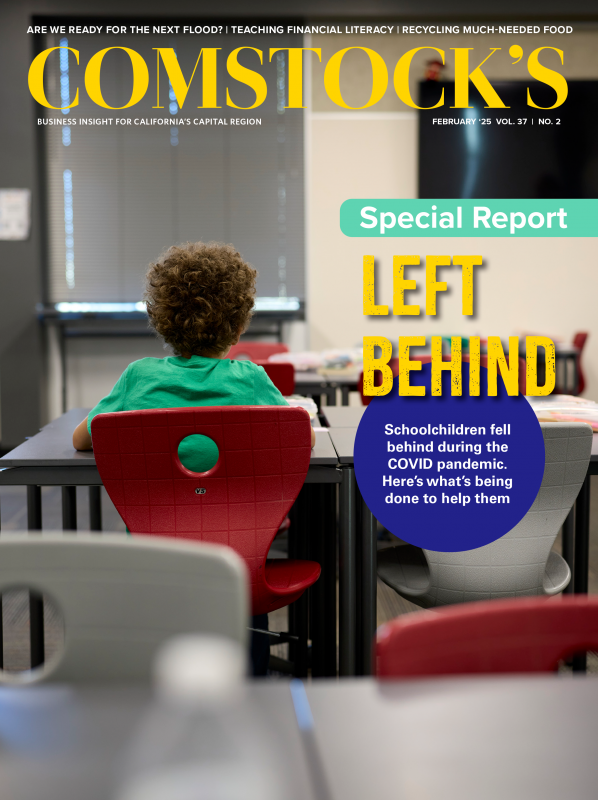On a foggy December morning in Joaquin Miller park in Oakland, scientist and educator Mario Gabiati hosts a meeting of the Mycelial Mass Mushroom Meetup group. The group includes mushroom enthusiasts of various levels of experience from the Bay Area, the Capital Region and beyond. Some have foraged before, others have found the event through the online application Meetup. Whether newcomers or practiced hands, all of the participants spend two hours awing over dewy caps peeking through pine needles — as well as building a connection with their natural environment.
At Gabiati’s encouragement, the foragers bring extra bags to collect any trash they encounter in the forest. Afterwards, the group gathers in Oakland’s Pomella cafe to identify their fungal findings. The baskets, buckets and bags are full of mushrooms both edible and inedible — bright and bulbous witches’ butter, striped turkey tail, orange (and poisonous) Jack-o’-lantern, red-topped Russulas and other boletes that are food for the eyes only.
“This area is unique because there’s a robust community of science-minded people, a diverse food culture and lots of opportunities for people who love to go outside,” Gabiati says of Northern California.
That description is also apt for the Capital Region, home to a rich agricultural tradition, a burgeoning food-tech startup scene, the annual Farm-to-Fork Festival and UC Davis, one of the world’s most prominent research institutions for food and agricultural science. So the farm-to-fork pipeline is well established in Sacramento — but what about forage-to-fork? We talked to some of the foragers, scientists, chefs and enthusiasts who want to see more foraging in the Capital Region.
The potential — and danger — of mushrooms
Brendan Linnane, co-owner of Foggy Dew Fungi in Auburn, displays
some of his bounty.

Gabiati has been foraging since 2008, when he was introduced to the world of fungi through his graduate program in conservation science at Scripps Institution of Oceanography in La Jolla. In addition to hosting the bimonthly Mycelial Mass Mushroom Meetup group, he also helps run the Circuit Launch BioLabs, which has a full DNA analysis lab he uses to identify different species of mushrooms.
He helps manage a lab space called Circuit Launch BioLabs, through which he runs a project called East Bay Fungal Genomics Project, funded by a grant from the Sonoma Mycological Association. His fungal genomics team also includes Dr. Cole Pruitt, Acorn Steed and Danielle Black. They are partnered with Circuit Launch, the San Francisco Microscopical Society and Bay Area Applied Mycology.
“I always want to make clear that these collaborations are the life-blood of organizations like the ones I run,” says Gabiati. “People sharing enthusiasm and resources are really the only way these types of organizations can thrive.”
Closer to the capital, UC Davis is home to several projects related to fungal research, including the Institute for Psychedelics and Neurotherapeutics, launched in 2023, and labs working with fungal-based food and engineering products.
Mushroom foraging is also on the rise. The Capital Region is home to large and growing communities of refugees and other migrants from regions such as Eastern Europe and Southeast Asia who continue their mushroom foraging traditions in their new home. Sacramento’s Iu Mien community, for example, have for years traveled annually to the Pacific Northwest to collect mushrooms that they then dry and use throughout the year.
But foraging comes with a risk, especially for mushrooms. False friends — lookalikes of edible varieties that cause sickness or poisoning — are especially dangerous, and expertise in foraging in one region does not guarantee safety in another. For example, foragers familiar with the edible species of Thailand may mistake California’s poisonous death cap mushroom for the edible paddy straw mushroom of East and Southeast Asia. Every year, a few people sicken in California from making this mistake; a high enough dose can be deadly.
Gabiati advocates for fostering awareness through citizen science. Crowd-sourced apps like iNaturalist are available to anyone and are developing into powerful tools with the help of AI; eventually, these could help both foragers identifying edible mushrooms and scientists looking for new fungal technologies. “The hope is to build a database that future scientists can use in developing everything from alternative fuels, biomaterials — mushroom ‘leather’ — and in bioremediation to clean up polluted soil, water and air,” he says.
Fungi in fine dining
While the Central Valley’s relatively dry climate is not as ideal for fungal growth as the wetter Bay, a bumper crop of mushrooms is appearing on farmers’ market and restaurant tables around the region. Local growers like Foggy Dew Fungi in Auburn supply chefs and enthusiasts with edible varieties like meaty oyster mushrooms and fluffy lion’s mane as well as varieties that are gaining popularity for their purported medicinal benefits, such as reishi.
“In the early days, we couldn’t sell lion’s mane if we tried; now we can’t keep up with demand,” says Foggy Dew co-owner Brendan Linnane. Originally based in Newcastle, Placer County, Foggy Dew rode that success to open a new, larger facility in Auburn.
Foggy Dew Fungi recently moved operations to a larger facility in
Auburn in response to growing demand for mushrooms.

From talking to people at the farmer’s market, Linnane found that people were interested in low tech ways to learn about and grow their own oyster mushrooms. Foggy Dew branched out to sell grow kits — mushroom blocks made out of natural sawdust, wheat bran and beet pulp to supply the nutrients required to fruit fresh mushrooms.
Tight margins make it more difficult to sell directly to restaurants, Linnane says. But he does supply a few, such as Pizzeria Luba and Restaurant Josephine in Auburn and The Chef’s Table in Rocklin.
Vegetarian restaurants make especially copious use of these meatless bundles of umami — downtown Sacramento’s Mother uses oyster mushrooms for its po’ boy (a clever play on the original New Orleans sandwich, which used fried oysters) and cooks down a variety of mushrooms into a rich “bolo-lasagna.”
Midtown’s Betty Wine Bar & Bottle Shop, which reopened in December under the leadership of Chef Chris Barnum-Dann of the Michelin-starred Localis, is finding creative ways to pair the complex flavors of mushrooms with their wide range of natural and local wines.
A recent menu paired a Spanish tempranillo wine with housemade Sicilian casarecce pasta tossed in pine nut butter, roasted maitake puree and a pine nut gastrique. “The tempranillo’s notes of berry and cherry work with the sweetness of the pine nut butter sauce and the gastrique, which is a vinegar based syrup,” says Betty Wine Bar Manager Cheryl Catera.
The thrill of the hunt
A few chefs in Northern California are making a name for themselves by combining kitchen skills with foraging know-how. One notable example is Chad Hyatt, freelance chef and author of “The Mushroom Hunter’s Kitchen.” His latest project is a mushroom-themed dinner in Santa Cruz. “Several of my close mushroom friends are from the Sacramento area, and I spend a lot of time foraging with them in the area, especially in the spring and late fall,” says Chad.
Hyatt found his niche in the mushroom world by chance. He fell in love with foraging when a post on now-obsolete Yahoo Chat tipped him off to a flush of porcini in the Sierra Nevada in the early 2000s. He took off work the next day to pick them, and soon his obsession was fully established.
“There’s a difference between those who ‘hunt’ the mushrooms and those who grow or cultivate them, though there is also a lot of overlap,” Hyatt says. But the hunters tend to love the mystery of not knowing what may appear. He takes that adventurous attitude into his own kitchen.
“I tend to follow the adage, ‘what grows together goes together,” he says. A porcini mushroom picked in the middle of a blueberry patch might inspire him to create “roasted quail with porcini stuffing and a blueberry red wine jus.”
Many of his ideas stem from personal connections and friendships he has forged during some of his foraging trips. He grew up on the East Coast with Ashkenazi Jewish and Eastern European roots before moving to the Bay Area, where he was exposed to a rich blend of Vietnamese, Japanese and Chinese culinary influences. He loves learning from and with others.
“People get into hunting mushrooms for all kinds of reasons, but one thing that makes it so special to me is how well it brings together family and friends of all ages, from little kids through grandparents, to enjoy the time in nature and the shared hunt,” he says.
Correction 2/13/25: Localis received its Michelin star in 2022, 2023 and 2024.
–
Stay up to date on Capital Region food news: Subscribe to the Comstock’s newsletter today.
Recommended For You

Food Tour Agencies Guide Customers on an Authentic Sacramento Experience
People don’t know where they’re going or what’s on the menu, just that there will be a variety of quality meals within walking distance. A food tour is a novel way to experience a place through an activity that appeals to and is accessible by all.
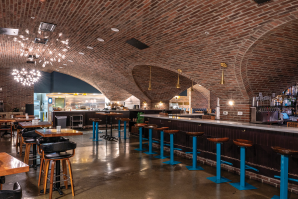
Theater Food: Not Just a Stage
Capital Region theaters offer more than popcorn
Crest Theatre (formerly Empress Theatre) and Empress Tavern, which have been open since 1912 and 2015, respectively, is just one theater-restaurant pairing where you can have a full night out in Sacramento. From downtown Sacramento to Oak Park, legacy theaters around the region are serving up both dinner and a show.
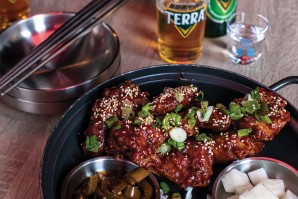
Late-Night Dining Returns to Sacramento
After a pandemic slump, it’s again possible to get a meal past midnight in the capital
When the pandemic put a plug on nightlife, some of the spots that fed that world either whittled down their hours or closed outright. In the past few years, though, options have been respawning on the grid and surrounding areas. Their colorful, contagiously optimistic atmosphere echoes the mood of Sacramento nightlife’s post-pandemic resurgence.
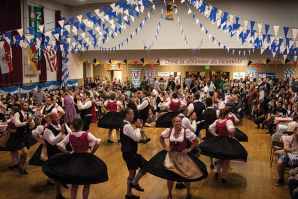
Celebrate Oktoberfest All Year Round
Here’s where you can enjoy German food, beer and culture in the Capital Region
You don’t need to fly all the way to Munich to get an authentic Oktoberfest experience, even after October draws to a close. Whether indoors or outdoors, in Sacramento, Rocklin or Elk Grove, this area has many biergartens and other German-style spots to choose from.
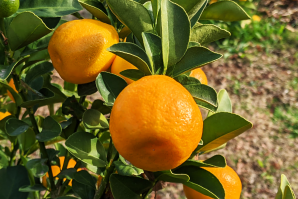
In Search of Pretty Produce
Consumers want big, bright fruit, nuts and other produce. How does that affect what farmers grow?
Cuties. Chandlers. Cilantro. They all start with the letter C, but what else do those words have in common? Popularity. Do consumer preferences impact farmers and what they choose to grow?
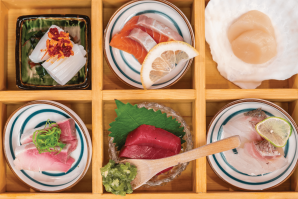
Omakase Reimagined
The Japanese tasting menu concept is branching out to other cuisines
Omakase has evolved from a Japanese culinary tradition mostly associated with high-end sushi restaurants to a dining concept that accommodates a wide range of palates.




